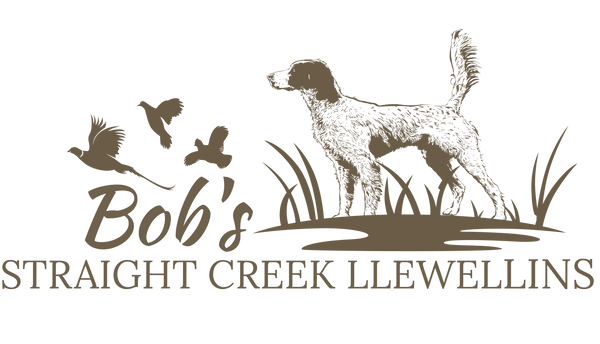What is a Llewellin Setter?
Nearly every person that visits our kennel for the first time asks the age-old question: What is a Llewellin Setter?

Most of these people have read one or all of the latest articles published by some of the major magazines in the past decade which cover the history of the Llewellins as early as the mid-1800s,. from the first Laveracks to Purcell Llewellin. With Llewellin the breed adopted the registered name.
"Why do you have Llewellins?" most hunters ask. Well, the first thing that comes to mind are stories my father tells of when as a boy in the 1940s hunting with dogs owned by hunters from the city, would pay 50 cents a day and a handful of shotgun shells to show them where the partridges (quail) were.
These medium sized black and white setters were Llewellins. They hunted Eastern Kentucky hills with ease, pointing, backing, honoring and retrieving.
Once the boy became a young man, he moved away from the hills for a number of years. Returning to the hills in search of roots near the old hometown of West Liberty in the 1960s he found outstanding populations of ruffed grouse and hillside quail.

For a hunting partner he chose, you guessed it, a Llewellin setter purchased from local friends who had kept the breed for years. This was the beginning of a three-and-a-half decade old program dedicated to a search for quality hunting dogs (not field trial) stock.
This led my father to begin a ten-year acquaintance with the late Ira Grist of Sardis, MS., who owned and imported Dashing Set Bondu dogs from William Humphry's kennels of England. He also owned Mr. Blizzard Sundance and some other American Llewellin lines. Before Mr. Grist died, Bob, my father, bought dogs from him and Postmaster Boyce Askques from Sardis, MS., who owned some of the American Bondu dogs.
Between Ira and Boyce, they produced fine hunting dogs that my father had the rare opportunity to hand-pick from the field and dogs from their personal hunting stocks. These dogs became perfectly suited for versatile gun dogs. These were the dogs that I was introduced to as a child.
Nearly twenty years have passed since that time. I have grown up to be an avid hunter and have hunted dogs throughout North America. These dogs became perfectly suited for a wide variety of upland game bird hunting. Not only were these dogs acclaimed for their close-range grouse hunting in the hardwood forests of the Appalachian foothills, but they could also hunt eight hours of crop ground in Kansas and Nebraska with ease, always willing and easy to handle.
During the 1980s, our love for these Llewellins began to pay off. The word was out: If you, the sportsman, are looking for a low-keyed, neat dog, a Llewellin may be the ticket." Not only were our kennels being recognized, but also lots of Llewellin breeders began to surface who had been around for years. Why just now?
Simple. The 1960s and 70s were bounty years for field trials and field trial breeders across America. But it became apparent that these dogs were not hunting dogs. With outcrossing of high-bred English dogs, which some breeders did, these were not the dogs my customers were looking for. The old fashion Llewellin setter had made a comeback.

As breeders and as professional gun dog trainers, we have compared Llewellin with nearly every other breed of pointing dog. It is our opinion that these dogs are in a class of their own. So why not put them in a class of their own?
In 1994, my father, Bob Bailey, contacted Burnie Mathis of American Field to explore the possibility of conducting a Llewellin gun dog field trial.
A restricted Llewellin-only gun dog trial was granted by American Field, which was held and run on Straight Creek Shooting Preserve at West Liberty, KY., December 3 and 4, 1994. The all-age winners of the trial were Dashing Iron Mike of Straight Creek Kennel and his daughter, Maggie Delight, owned by Robert DeKamp of North Vernon, Ind. Mike was purchased from Olden Chapman of Oblong, Il. Mike is a son of Highland Bandit, owned by Byron Sanders of Indiana. Mike's mother is Chappy Sugar Babe, owned by Olden Chapman of Oblong,Il.
The night prior to the trial, the ground rules were submitted by a group of Llewellin owners and breeders from seven states.
This trial would be designated to welcome the average gun dog and his owner and to prove what it takes to be a winner without the high expense of horses and trailers and professional training bills.
We wanted to see old fashion Llewellin setters in action. Therefore, rules were set accordingly. Dad was onto something. He got backing from American Field, pulled the owners and trainers together, and held the trial. It was a tremendous success. Since then, restrictive Llewellin gun dog trials have been held in Georgia, South Carolina, Missouri, and Connecticut. But the biggest step since the first trial was the organizing of the Llewellin Gun Dog Club Dec. 7, 1996, with officers elected as follows: Joe Noe, Illinois, president; Keith Smith, Pennsylvania, vice-president; Roy Sparks, Indiana, secretary; Lori Noe, Illinois, treasurer.
This club has also worked its way to an open classic trial which will be held April 5 and 6, 1997 at Shoe Leather Kennels, Tiskilwa, Il., hosted by Joe and Lori Noe.
Down the road, in three years, we will be going for national Llewellin champion. P.S. We at Straight Creek Kennels believe that Llewellin gun dog trials will make Llewellin breeders try to breed a better gun dog.
There you have it, my lifelong connection with the Llewellin setters. What better reason to not only uphold the breed but also develop it to a higher level of gun dog.
By Steve Bailey
